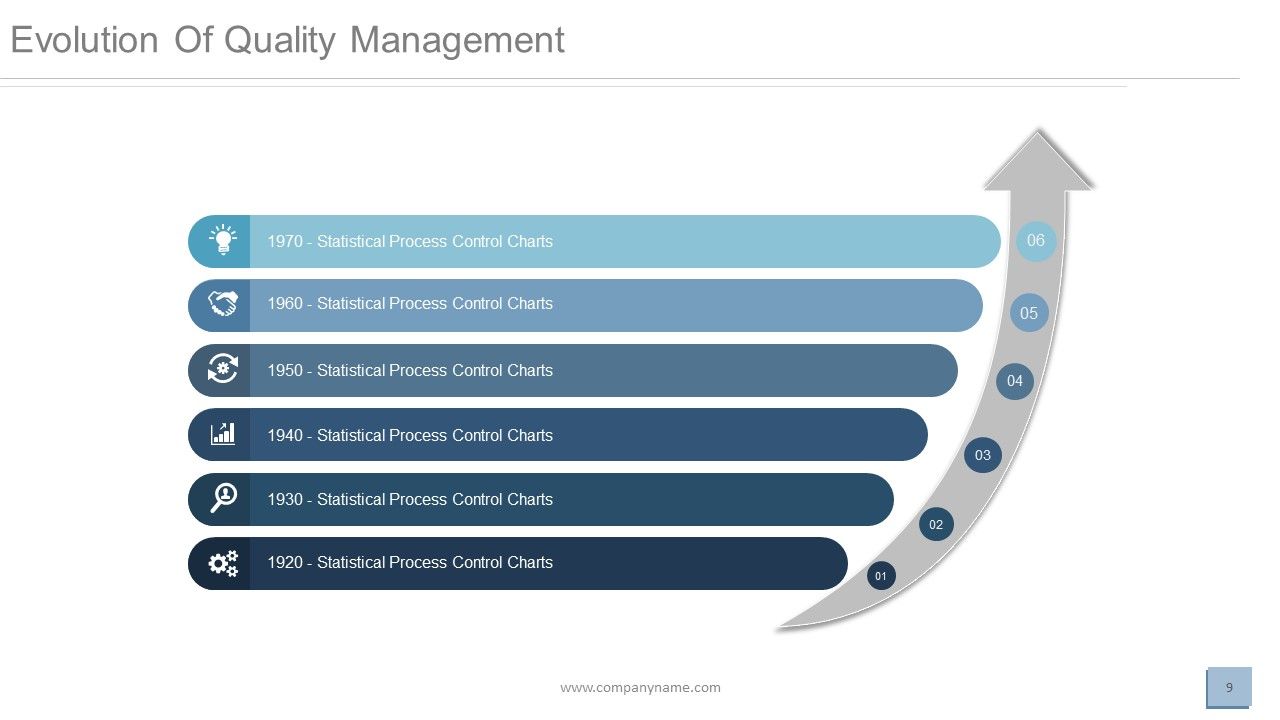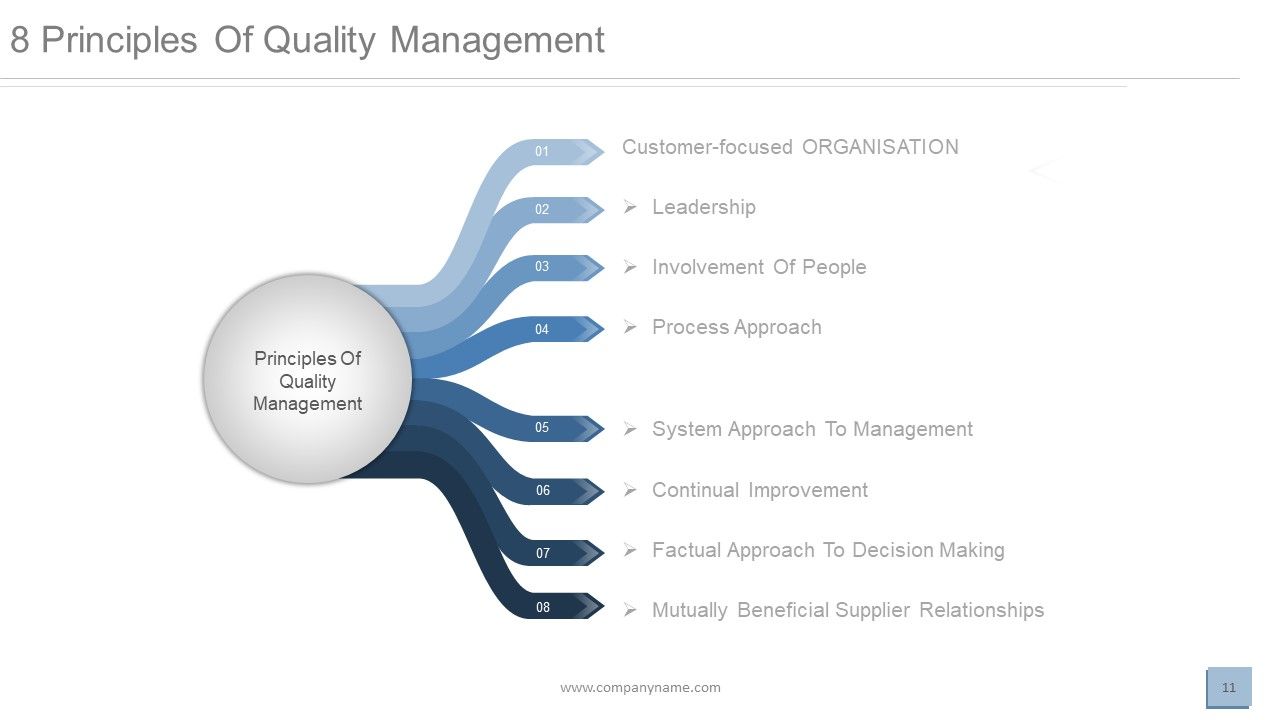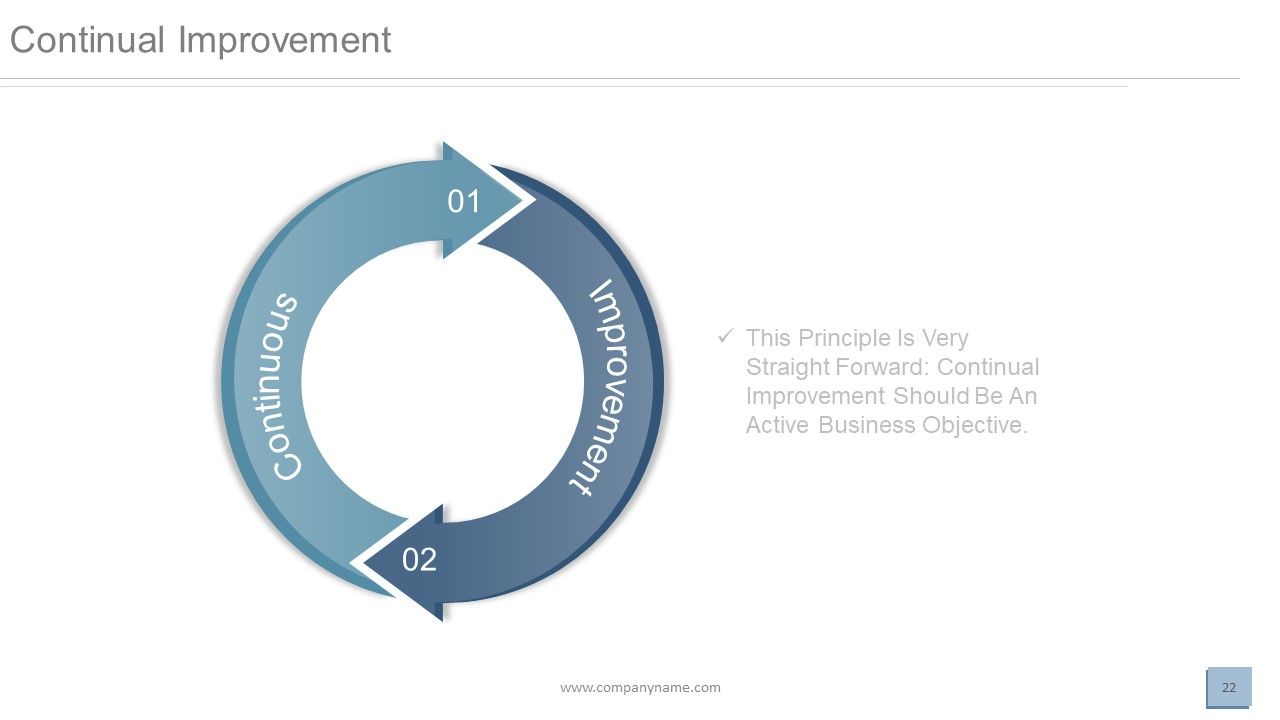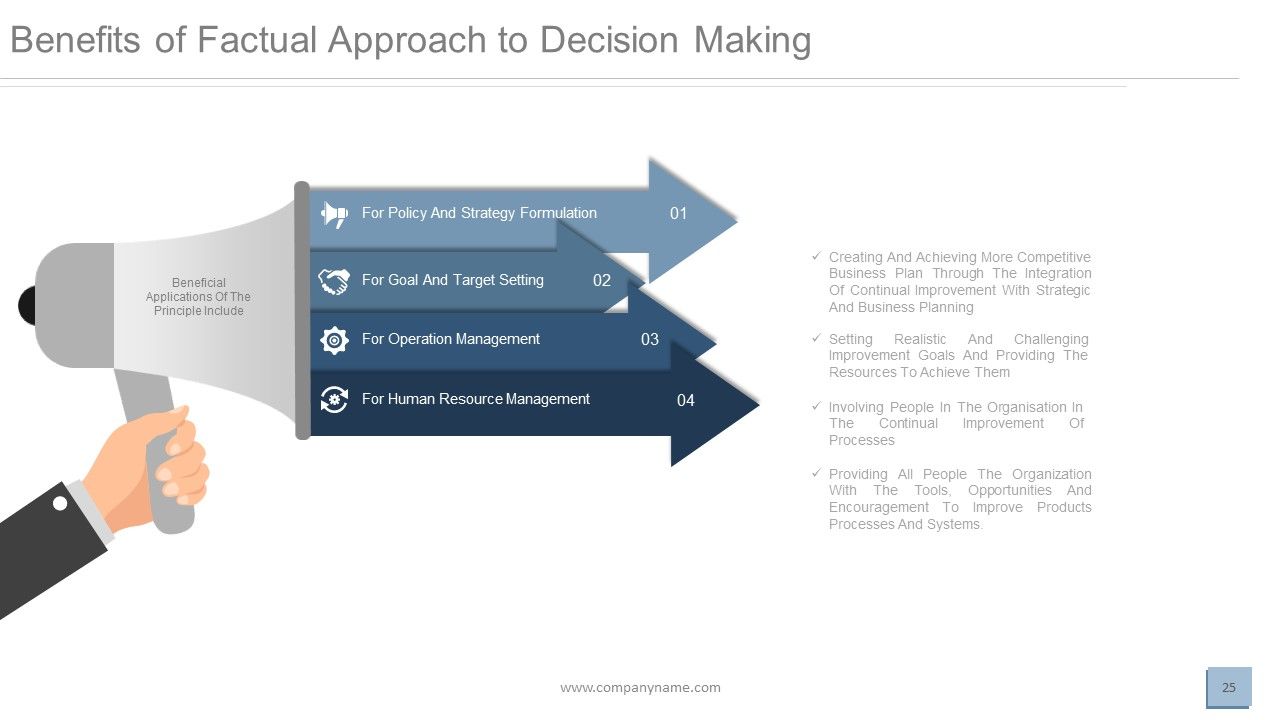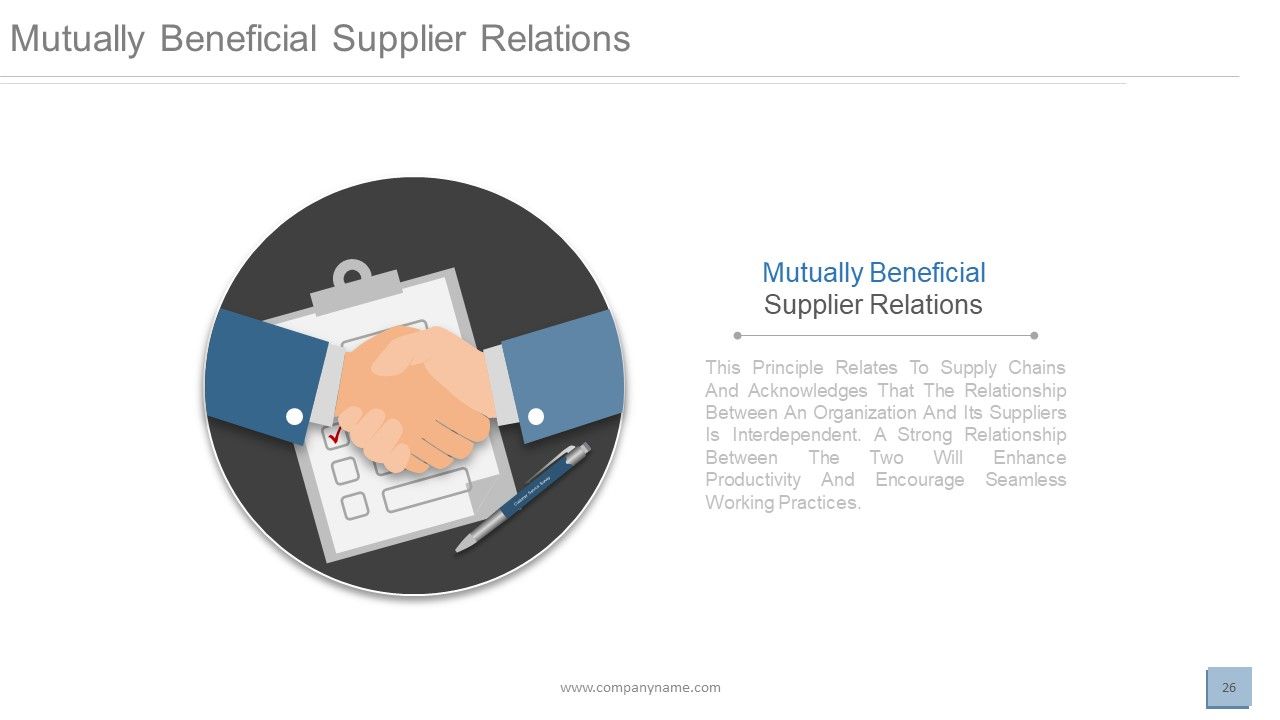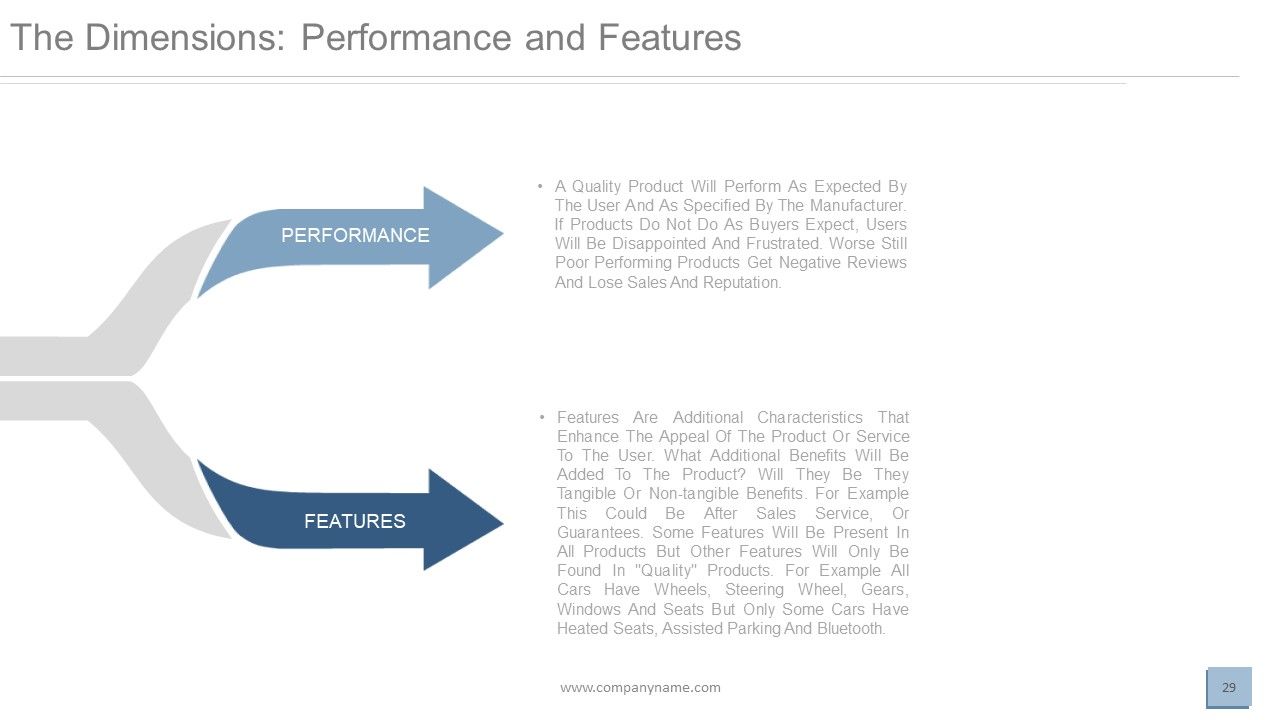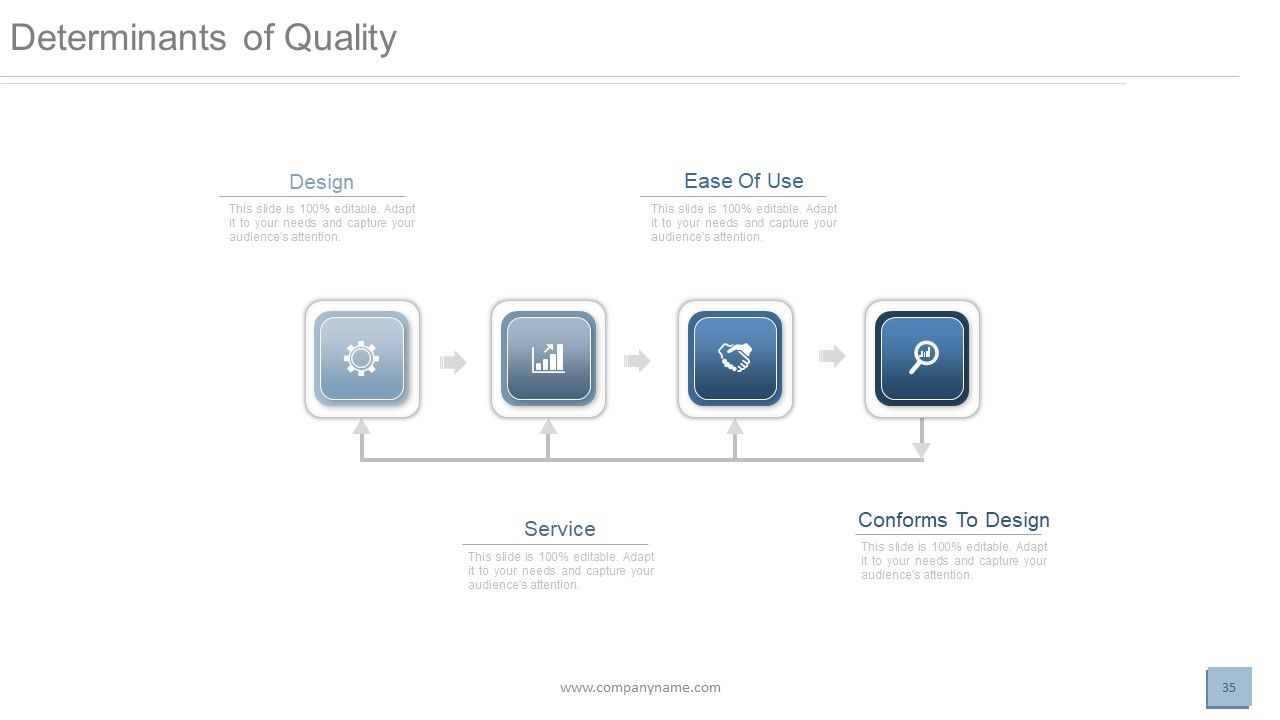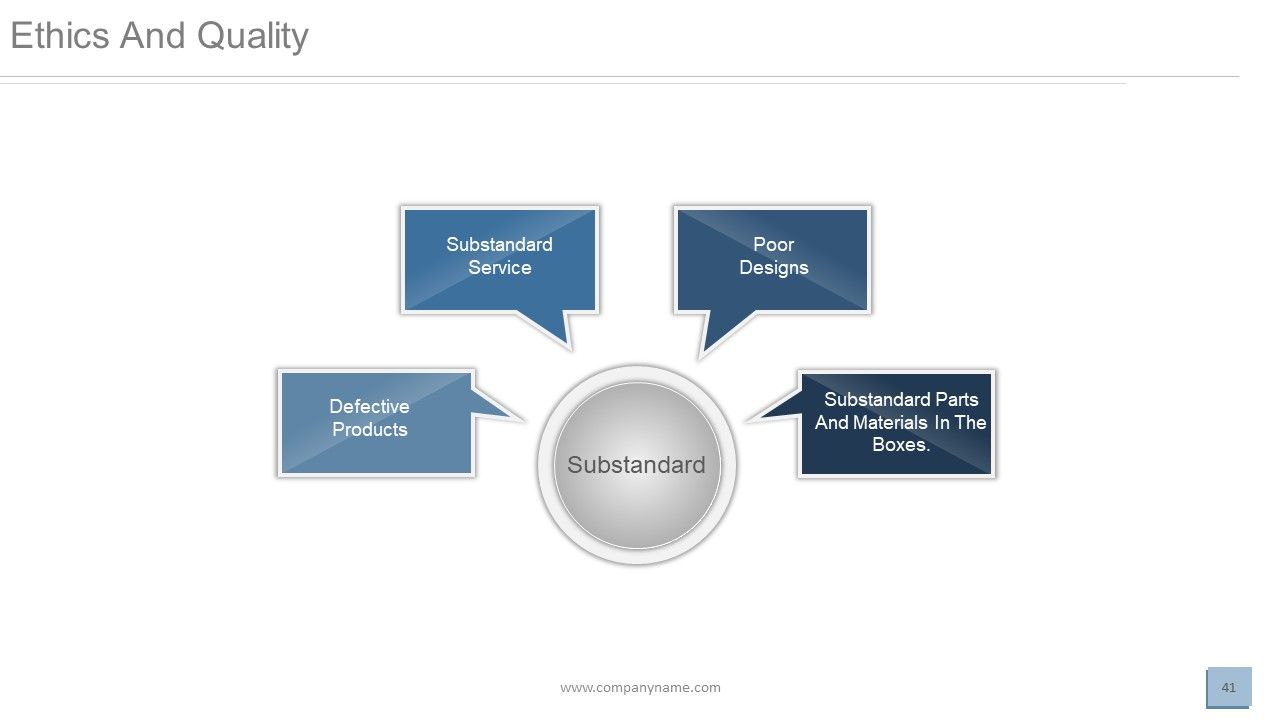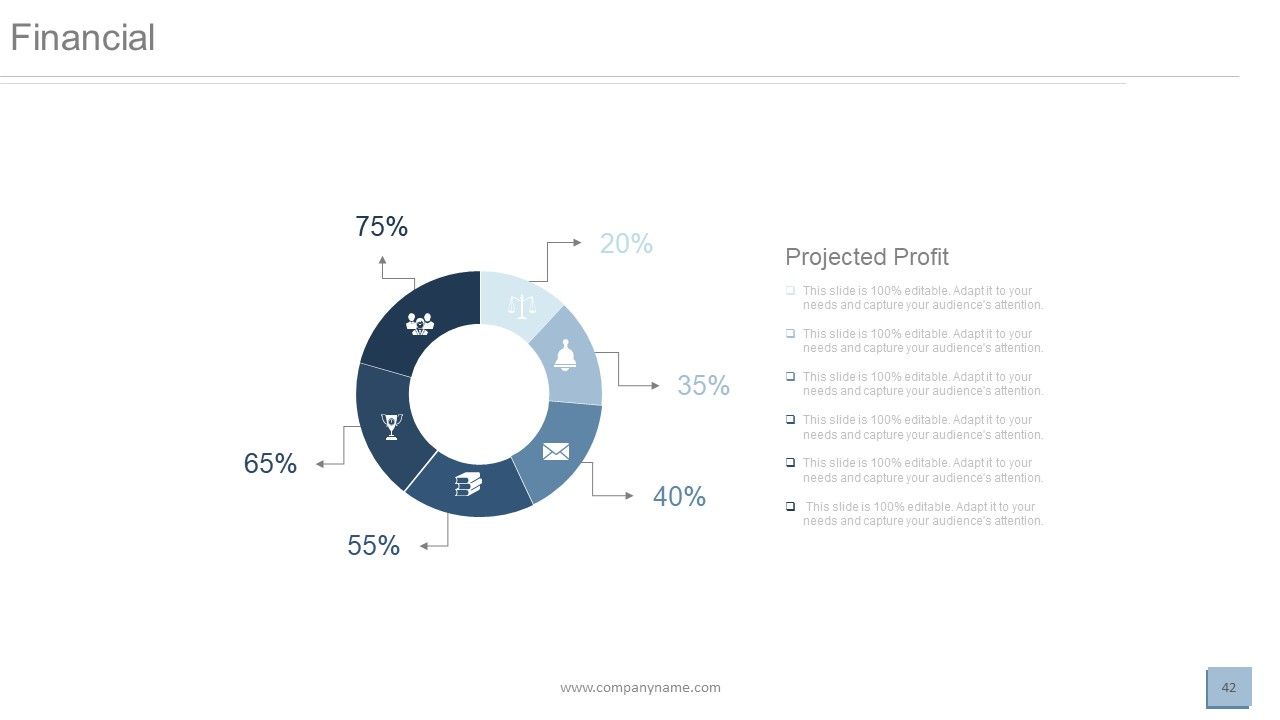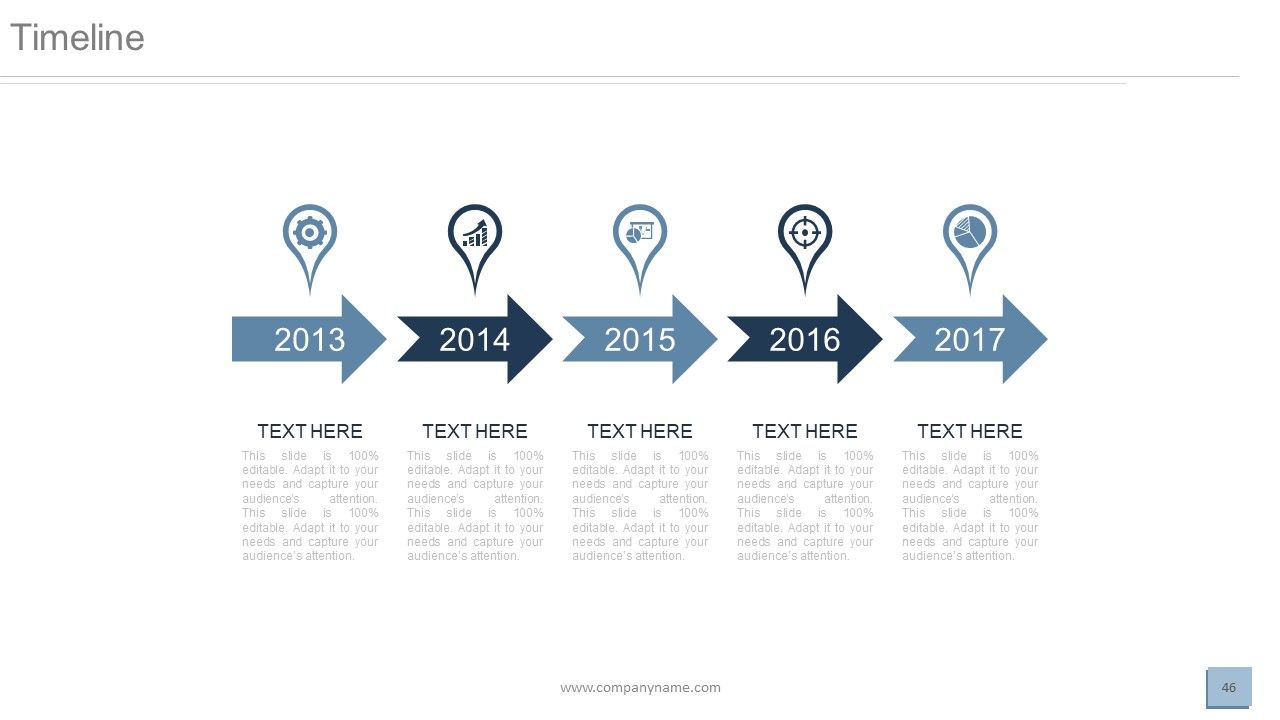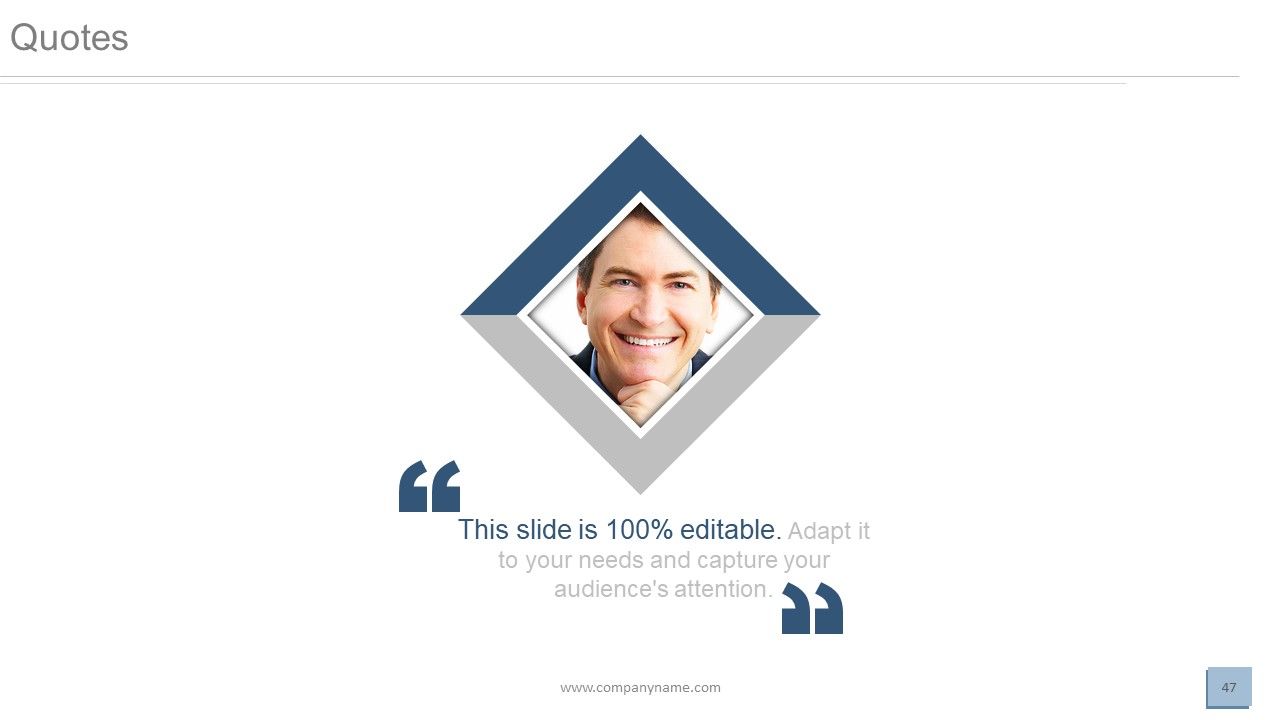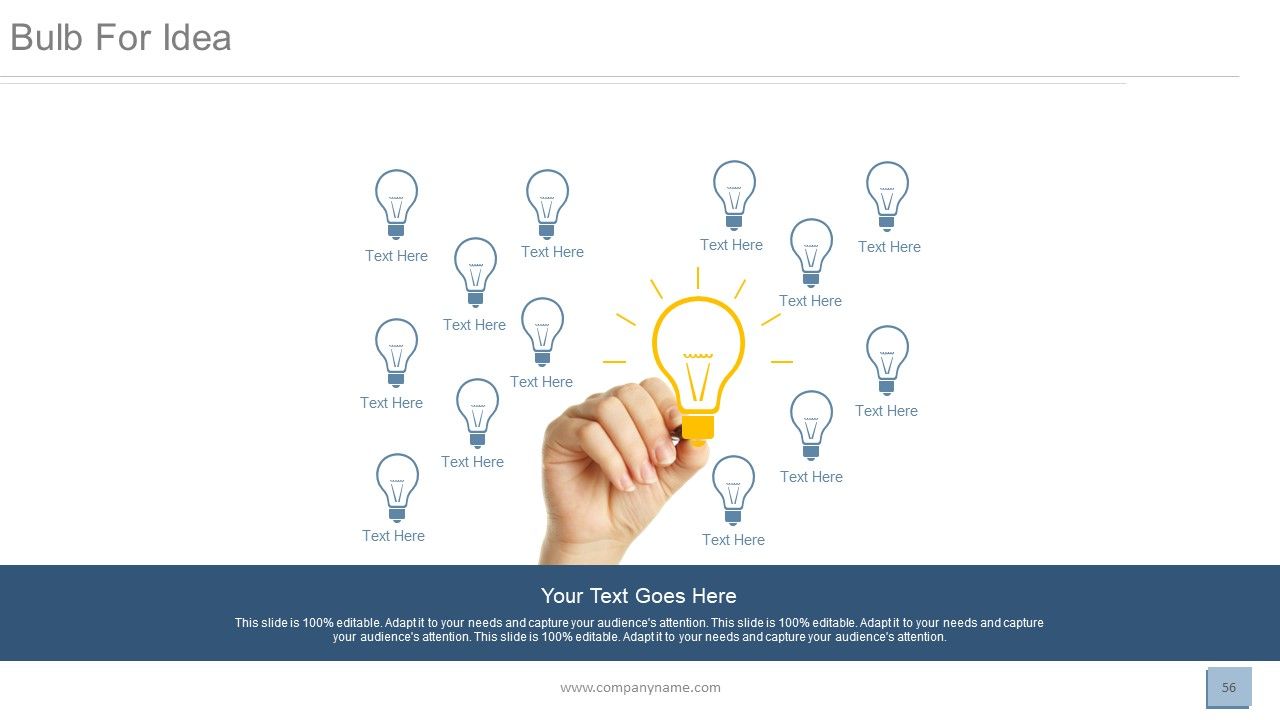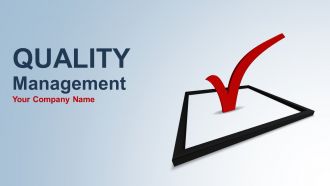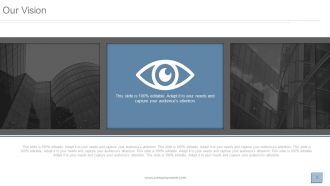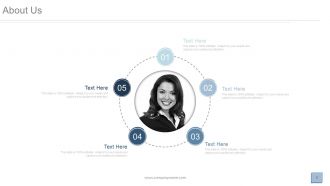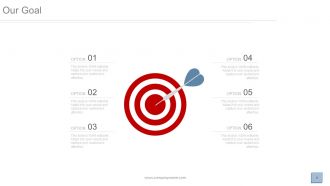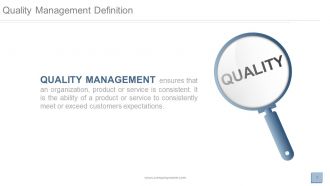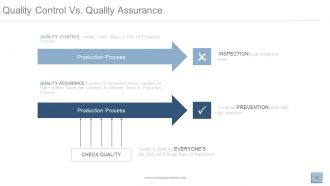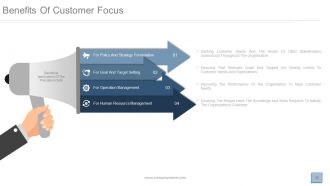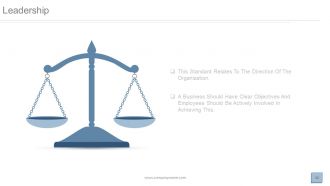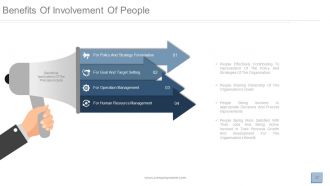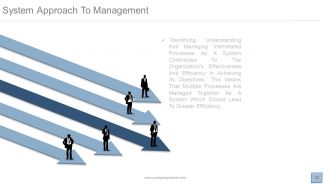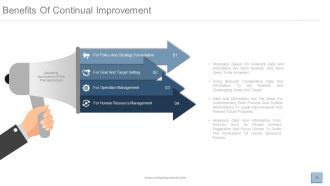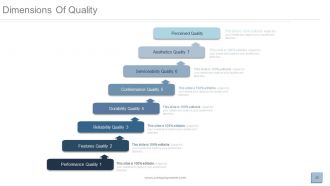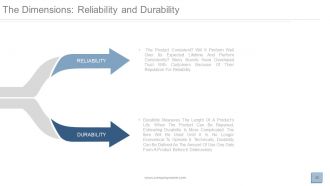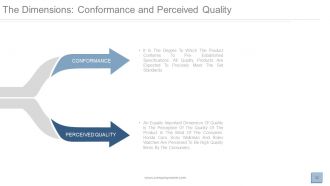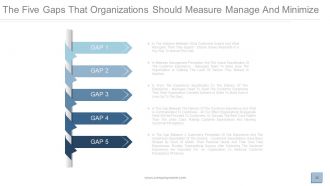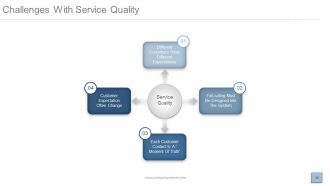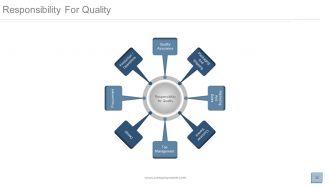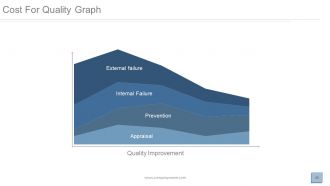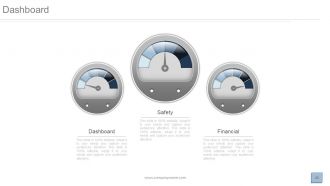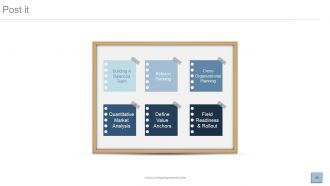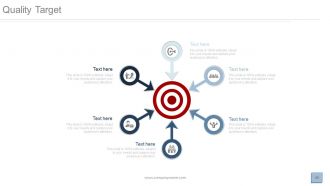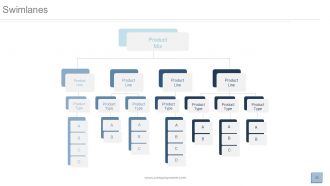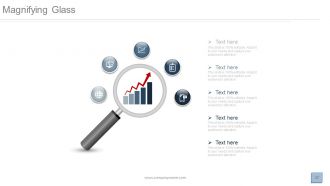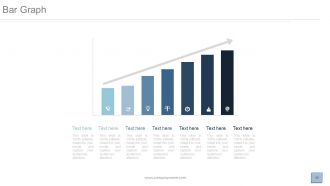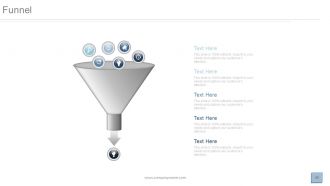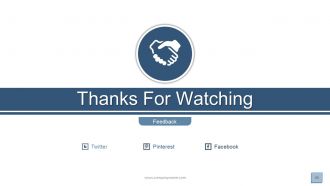Quality management assurance focus and approach powerpoint presentation with slides
Every successful business needs its products to be top-notch. So, it is very important to have products that are great. To have great product we need quality assurance. This means all professionals need PPT presentation to brief employees about good quality assurance management. Keeping this in mind we are presenting a 60 slides content-ready Quality Management Assurance Focus And Approach PowerPoint Presentation With Slides. Using this QA PPT sample deck you can underline various quality assurance methods and its importance. There are slide like quality management definition, main components of quality management, evolution of quality management, quality control vs quality assurance, customer focus and its benefits, leadership, continual improvement, factual approach to decision making and many more. Furthermore, this PPT example supports to share insights about QA and QC requirement, policy and how it can be achieved. The best part is that this PPT sample deck is fully editable. Moreover, you can also update your employees about the various technical risks in a quality system for total quality management. Apart from this, presentation sample designs like benefits of customer focus, involvement of people, service GAP model, challenges with service quality, process approach, system approach to management, dimensions of quality etc. makes this professional PowerPoint show even more impressive. So just download Quality Management Assurance Focus And Approach PowerPoint Presentation With Slides and leave your mark. In short, a complete readymade QM plan PPT sample package for Quality Mangers or Quality Controllers to set a jaw dropping PPT example.
You must be logged in to download this presentation.
 Impress your
Impress your audience
Editable
of Time
PowerPoint presentation slides
Presenting Quality Management Assurance Focus And Approach complete PowerPoint presentation with editable PPT slides. All slides are professionally designed by our team of PowerPoint designers. The presentation content covers all areas of QA and QC and is extensively researched. This ready-to-use deck comprises visually stunning PowerPoint templates, icons, visual designs, data-driven charts and graphs and business diagrams. The deck consists of a total of 60 slides. You can customize this presentation as per your branding needs. You can change the font size, font type, colors as per your requirement. Download the presentation, enter your content in the placeholders and present with confidence!
People who downloaded this PowerPoint presentation also viewed the following :
Content of this Powerpoint Presentation
Slide 1: This slide introduces Quality Management. State Your Company Name and get started.
Slide 2: This is an Agenda slide. State company agendas here in a professional manner.
Slide 3: This is Our Vision slide. State company vision here.
Slide 4: This is Our Team slide with name, designation and image boxes.
Slide 5: This is an About Us slide. State team/company specifications here.
Slide 6: This is Our Goal slide. State goals etc. here. l
Slide 7: This slide states Quality Management Definition.
Slide 8: This slide presents Four Main Components Of Quality Management namely- Quality Assurance, Quality Control, Quality Planning, Quality Improvement, Quality Management.
Slide 9: This slide presents Evolution Of Quality Management.
Slide 10: This slide presents Quality Control Vs. Quality Assurance showcasing- Production Process, Check Quality, Inspection, and Prevention.
Slide 11: This slide presents 8 Principles Of Quality Management such as- Customer-focused Oganization, Leadership, Involvement Of People, Process Approach, System Approach To Management, Continual Improvement, Factual Approach To Decision Making, Mutually Beneficial Supplier Relationships.
Slide 12: This slide presents Customer Focus showcasing- Where Possible, They Should Aim To Exceed Customer Expectations. This Standard Relates To Customer Needs And Customer Service. A Business Should Understand Their Customers And Seek To Meet Their Requirements.
Slide 13: This slide states Benefits Of Customer Focus showcasing- Marking Customer Needs And The Needs Of Other Stakeholders Understood Throughout The Organisation, Ensuring That Relevant Goals And Targets Are Directly Linked To Customer Needs And Expectations, Improving The Performance Of The Organisation To Meet Customer Needs, Ensuring The People Have The Knowledge And Skills Requires To Satisfy The Organization's Customer, headed under For Policy And Strategy Formulation, For Goal And Target Setting, For Operation Management, For Human Resource Management.
Slide 14: This slide showcases Leadership showing- A Business Should Have Clear Objectives And Employees Should Be Actively Involved In Achieving This. This Standard Relates To The Direction Of The Organization.
Slide 15: This slide showcases Benefits Of Leadership showing- Establishing And Communicating A Clear Vision Of The Organisation’ S Future, Translating The Vision Of The Organisation Into Measurable Goals And Targets, Empowered And Involved People Achieve The Organisation's Objectives, Having An Empowered, Motivated, Well Informed And Stable Workforce, headed under For Policy And Strategy Formulation, For Goal And Target Setting, For Operation Management, For Human Resource Management.
Slide 16: This slide shows Involvement Of People with- This Principle Recognizes That An Organization Is Nothing Without Its Staff, That Their Abilities Should Be Used To Full Effect For Business Success.
Slide 17: This slide presents Benefits Of Involvement Of People- People Effectively Contributing To Improvement Of The Policy And Strategies Of The Organisation, People Sharing Ownership Of The Organisation’s Goals, People Being Involved In Appropriate Decisions And Process Improvements, People Being More Satisfied With Their Jobs And Being Active Involved In Their Personal Growth And Development For The Organisation’s Benefit, headed under For Policy And Strategy Formulation, For Goal And Target Setting, For Operation Management, For Human Resource Management.
Slide 18: This slide showcases Process Approach. The Process Approach Relates To Efficiency And The Understanding That Appropriate Processes Will Speed Up Activities.
Slide 19: This slide shows Benefits Of Process Approach with- Utilizing Defines Processes Throughout The Organization Will Lead To More Predictable Results Better Use Of Resources Shorter Cycle Times And Lower Costs, Understanding The Capability Of Processes Enables The Creation Of Challenging Goals And Targets, Adopting The Process Approach For All Operation Results In Lower Costs Prevention Of Errors Control Of Variation Shorter Cycle Times And More Predictable Outputs, headed under For Policy And Strategy Formulation, For Goal And Target Setting, For Operation Management.
Slide 20: This slide showcases System Approach To Management. "Identifying, Understanding And Managing Interrelated Processes As A System Contributes To The Organization's Effectiveness And Efficiency In Achieving Its Objectives.” This Means That Multiple Processes Are Managed Together As A System Which Should Lead To Greater Efficiency.
Slide 21: This slide shows Benefits Of System Approach To Management with- The Creation Of Comprehensive And Challenging Plans That Link Functional And Process Inputs, The Goals And Targets Of Individual Processes Are Aligned With The Organization's Key Objective, A Broader Overview Of The Effectiveness Of Processes Which Leads To Understanding The Causes Of Problems And Timely Improvement Action, Provides A Better Understanding Of Roles And Responsibilities For Achieving Common Objectives Thereby Reducing Cross Functional Barriers And Improving, headed under For Policy And Strategy Formulation, For Goal And Target Setting, For Operation Management, For Human Resource Management.
Slide 22: This slide showcases Continual Improvement. This Principle Is Very Straight Forward: Continual Improvement Should Be An Active Business Objective.
Slide 23: This slide presents Benefits Of Continual Improvement with- Strategies Based On Relevant Data And Information Are More Realistic And More Likely To Be Achieved, Using Relevant Comparative Data And Information To Set Realistic And Challenging Goals And Target, Data And Information Are The Basis For Understanding Both Process And System Performance To Guide Improvements And Prevent Future Problems, Analysing Data And Information From Sources Such As People Surveys Suggestion And Focus Groups To Guide The Formulation Of Human Resource Policies, headed under For Policy And Strategy Formulation, For Goal And Target Setting, For Operation Management, For Human Resource Management.
Slide 24: This slide presents Factual Approach To Decision Making. A Logical Approach, Based On Data And Analysis, Is Good Business Sense. Unfortunately, In A Fact Paced Workplace, Decisions Can Often Be Made Rashly, Without Proper Thought. The Efficiency That Will Have Been Imbued In The Organization After The Implementation Of Prior Principles Will Allow Decisions To Be Made With Clarity.
Slide 25: This slide presents Benefits of Factual Approach to Decision Making with- Creating And Achieving More Competitive Business Plan Through The Integration Of Continual Improvement With Strategic And Business Planning, Setting Realistic And Challenging Improvement Goals And Providing The Resources To Achieve Them, Involving People In The Organisation In The Continual Improvement Of Processes, Providing All People The Organization With The Tools, Opportunities And Encouragement To Improve Products Processes And Systems, headed under For Policy And Strategy Formulation, For Goal And Target Setting, For Operation Management, For Human Resource Management.
Slide 26: This slide showcases Mutually Beneficial Supplier Relations. This Principle Relates To Supply Chains And Acknowledges That The Relationship Between An Organization And Its Suppliers Is Interdependent. A Strong Relationship Between The Two Will Enhance Productivity And Encourage Seamless Working Practices.
Slide 27: This slide shows Benefits of Mutually Beneficial Supplier Relations with- Strategies Based On Relevant Data And Information Are More Realistic And More Likely To Be Achieved, Using Relevant Comparative Data And Information To Set Realistic And Challenging Goals And Target, Data And Information Are The Basis For Understanding Both Process And System Performance To Guide Improvements And Prevent Future Problems, Analysing Data And Information From Sources Such As People Surveys Suggestion And Focus Groups To Guide The Formulation Of Human Resource Policies, headed under For Policy And Strategy Formulation, For Goal And Target Setting, For Operation Management, For Human Resource Management.
Slide 28: This slide presents Dimensions Of Quality with- Performance Quality 1, Features Quality 2, Reliability Quality 3, Durability Quality 4, Conformance Quality 5, Aesthetics Quality 7, Perceived Quality, Serviceability Quality 6.
Slide 29: This slide presents The Dimensions: Performance and Features A Quality Product Will Perform As Expected By The User And As Specified By The Manufacturer. If Products Do Not Do As Buyers Expect, Users Will Be Disappointed And Frustrated. Worse Still Poor Performing Products Get Negative Reviews And Lose Sales And Reputation. Features Are Additional Characteristics That Enhance The Appeal Of The Product Or Service To The User. What Additional Benefits Will Be Added To The Product? Will They Be They Tangible Or Non-tangible Benefits. For Example This Could Be After Sales Service, Or Guarantees. Some Features Will Be Present In All Products But Other Features Will Only Be Found In "Quality" Products. For Example All Cars Have Wheels, Steering Wheel, Gears, Windows And Seats But Only Some Cars Have Heated Seats, Assisted Parking And Bluetooth.
Slide 30: This slide shows The Dimensions: Reliability and Durability. The Product Consistent? Will It Perform Well Over Its Expected Lifetime And Perform Consistently? Many Brands Have Developed Trust With Customers Because Of Their Reputation For Reliability. Durability Measures The Length Of A Product’s Life. When The Product Can Be Repaired, Estimating Durability Is More Complicated. The Item Will Be Used Until It Is No Longer Economical To Operate It. Technically, Durability Can Be Defined As The Amount Of Use One Gets From A Product Before It Deteriorates.
Slide 31: This slide shows The Dimensions: Serviceability and Aesthetics. Serviceability Refers To The Promptness, Courtesy, Proficiency And Ease In Repair When The Product Breaks Down And Is Sent For Repairs. Aesthetic Aspect Of A Product Is Comparatively Subjective In Nature And Refers To Its Impact On The Human Senses Such As How It Looks, Feels, Sounds, Tastes And So On, Depending Upon The Type Of Product.
Slide 32: This slide shows The Dimensions: Conformance and Perceived Quality. It Is The Degree To Which The Product Conforms To Pre- Established Specifications. All Quality Products Are Expected To Precisely Meet The Set Standards. An Equally Important Dimension Of Quality Is The Perception Of The Quality Of The Product In The Mind Of The Consumer. Honda Cars, Sony Walkman And Rolex Watches Are Perceived To Be High Quality Items By The Consumers.
Slide 33: This slide shows the Service GAP Model displaying- Expected Service, Perceived Service, Service Delivery(Including Per-And Post Contacts), Translation Of Perceptions Into Service Quality Specifications, Management Perceptions Of Consumer Expectations, World Of Mouth, Personal Needs, Post Experience, External Communication To Customers, Customer, Provider.
Slide 34: This slide presents The Five Gaps That Organizations Should Measure Manage And Minimize. They are- Is The Distance Between What Customers Expect And What Managers Think They Expect - Clearly Survey Research Is A Key Way To Narrow This Gap. Is Between Management Perception And The Actual Specification Of The Customer Experience - Managers Need To Make Sure The Organization Is Defining The Level Of Service They Believe Is Needed. Is From The Experience Specification To The Delivery Of The Experience - Managers Need To Audit The Customer Experience That Their Organization Currently Delivers In Order To Make Sure It Lives Up To The Spec. Is The Gap Between The Delivery Of The Customer Experience And What Is Communicated To Customers - All Too Often Organizations Exaggerate What Will Be Provided To Customers, Or Discuss The Best Case Rather Than The Likely Case, Raising Customer Expectations And Harming Customer Perceptions. Is The Gap Between A Customer's Perception Of The Experience And The Customer's Expectation Of The Service - Customers' Expectations Have Been Shaped By Word Of Mouth, Their Personal Needs And Their Own Past Experiences. Routine Transactional Surveys After Delivering The Customer Experience Are Important For An Organization To Measure Customer Perceptions Of Service.
Slide 35: This slide showcases Determinants of Quality with- Design, Ease Of Use, Conforms To Design, Service.
Slide 36: This slide shows Challenges With Service Quality such as- Customer Expectation Often Change, Different Customers Have Different Expectations, Each Customer Contact Is A “ Moment Of Truth”, Fail-safing Must Be Designed Into The System.
Slide 37: This slide shows Consequences Of Poor Quality displaying- Loss Of Business Liability Productivity (Rework, Defective Output That Must Be Scrapped) Costs (Rework, Scrap, Warranty Cost, Etc.)
Slide 38: This slide shows Responsibility for Quality with- Quality Assurance, Top Management, Packaging And Shipping, Design, Production / Operations, Customer Service, Procurement, Marketing And Sales, Responsibility For Quality.
Slide 39: This slide shows Cost For Quality- Total Cost Of Quality, Cost Of Good Quality, Cost Of Poor Quality, Prevention, Appraisal, Internal Failure, External Failure.
Slide 40: This slide displays Cost For Quality Graph showing- External failure, Internal Failure, Prevention, Appraisal, Quality Improvement.
Slide 41: This slide showcases Ethics And Quality displaying- Substandard Service, Poor Designs, Substandard Parts And Materials In The Boxes, Defective Products.
Slide 42: This is a Financial score slide showcasing- Projected Profit
Slide 43: This is a Dashboard slide to state metrics, kpis etc.
Slide 44: This is a Comparison slide for comparing entities/products etc. here.
Slide 45: This is a Location slide of world map image to show global presence, growth etc.
Slide 46: This is a Timeline slide to show evolution, growth, milestones etc.
Slide 47: This is a Quotes slide to convey company messages, beliefs etc. You can change the slide contents as per need.
Slide 48: This is a Post It slide to mark events, important information etc. such as- Building A Balanced Team, Release Planning Cross Organizational Planning, Quantitative Market Analysis, Define Value Anchors, Field Readiness & Rollout.
Slide 49: This is a Puzzle Swot image slide.
Slide 50: This is Quality Target image slide. State targets, etc. here.
Slide 51: This is a Circular image slide to show information, specifications etc.
Slide 52: This is a Venn diagram image slide to show information, specifications etc. to show- Commitment, Direction or Capability as examples.
Slide 53: This is a Matrix slide to show information, specifications etc.
Slide 54: This is a Silhouettes image slide to show people related information, specifications etc.
Slide 55: This slide presents Swimlanes displaying- Product Mix, Product Line, Product Type.
Slide 56: This is a Bulb for Idea image slide to show information, specifications, innovative aspects etc.
Slide 57: This is a Magnifying glass image slide to show information, specifications etc.
Slide 58: This is a Bar Graph image slide to show product/entity comparison, information etc.
Slide 59: This is a Funnel image slide to show information, specifications etc.
Slide 60: This is a Thanks For Watching slide with Feedback.
Quality management assurance focus and approach powerpoint presentation with slides with all 60 slides:
Group dynamics evolve with our Quality Management Assurance Focus And Approach Complete Powerpoint Deck. Develop a feeling of collaboration.
FAQs
The four main components of quality management are Quality Assurance, Quality Control, Quality Planning, and Quality Improvement.
The benefits of the process approach to quality management include more predictable results, better use of resources, shorter cycle times, and lower costs.
The benefits of customer focus in quality management include improving the performance of the organization to meet customer needs, ensuring relevant goals and targets are directly linked to customer needs and expectations, and ensuring people have the knowledge and skills required to satisfy the organization's customer.
The system approach to management in quality management involves identifying, understanding, and managing interrelated processes as a system to contribute to the organization's effectiveness and efficiency in achieving its objectives.
The factual approach to decision-making in quality management involves analyzing data and information to guide the formulation of policies and strategies for goal and target setting, operation management, and human resource management.
-
Very Good
-
Perfect template with attractive color combination.
-
Professional and unique presentations.











